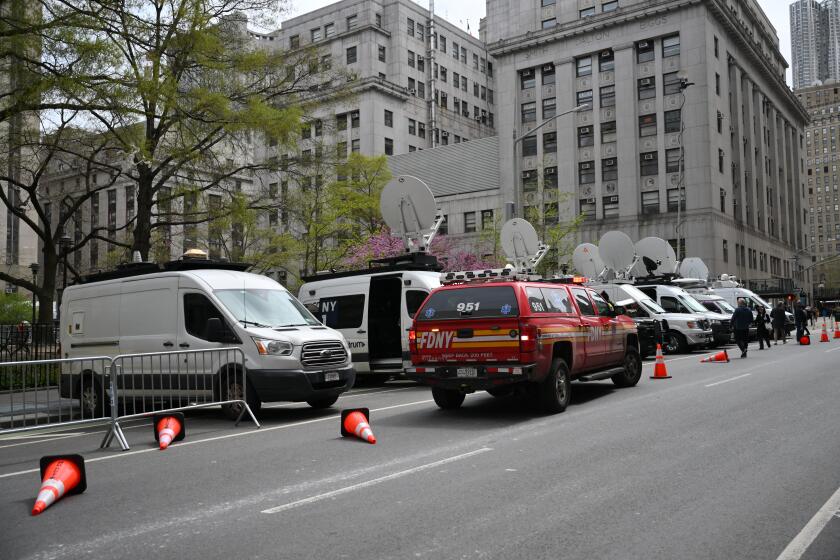Where’s the rose between his teeth?
LAST WEEK, I got a phone call from a television news producer who asked me what Mayor Antonio Villaraigosa’s extramarital affair revealed about the nature of Latino political leadership. I told her I’d agree to be interviewed on air only if we could explore what Bill Clinton’s dalliances said about white people or Jesse Jackson’s fling with an aide told us about black activists. Dumbfounded, she asked if I could refer her to someone else.
Remember two short years ago, when The Times rhapsodized on the front page about Villaraigosa’s electoral triumph? His victory party was described in glorious terms, “with downtown skyscrapers as a backdrop and lavender jacaranda trees glowing under lights shining from the rooftop.” Ah, yes, this Latino mayor, who promised to “govern for all Angelenos,” was expected to usher in an era of ethnic cooperation.
Of course, there were the inevitable “Latinos have arrived” articles in the press. (I even wrote one for the Newsweek edition that had Villaraigosa’s mug on the front cover over a headline that read, “Latino Power.”) But as the weeks went on and the wheels of municipal governance turned, the mayor’s ethnicity became less and less part of the story. Sure, it was mentioned when he took a trade delegation to Mexico, but not when he tried to take over the school district, raised trash collection fees to hire more police officers, cleared the way to study the possibility of building a subway to the sea, or launched an initiative to plant a million new trees. For a brief moment, the media seemed to understand that, other than some ethnic symbolism and his ability to speak serviceable Spanish, a Mexican American mayor behaved pretty much like any other politician.
But that was before the revelation of the mayor’s extramarital affair with Telemundo anchorwoman Mirthala Salinas, and the media gratuitously injected ethnicity into the scandal. Maybe, it would have been different if she worked for CBS, but I don’t think so. Reporters from a variety of newspapers, including The Times, the Washington Post, the San Francisco Chronicle and the LA Weekly made lame comparisons between the mayor’s affair and telenovelas, Spanish-language soap operas. Do you think they didn’t write “soap opera” because the English-language versions lack sufficient sex and intrigue? Or maybe it was a cute way to ascribe this behavior, as opposed to planting trees, to his ethnicity.
After hearing that Salinas had dated two other Mexican American politicians, Fabian Núñez and Alex Padilla, Times columnist Steve Lopez joked that the three men were playing a game of “¿Quién Es Más Macho?,” a phrase comedian Bill Murray came up with on “Saturday Night Live” in a 1979 takeoff on Latino stereotypes. Because — heh, heh — you know what they say about those Latin men.
I’m surprised no newspaper ran a cartoon of the mayor sporting a pencil mustache, a Zorro mask and a rose clenched between his teeth.
Would all this winking ethnic innuendo be tolerated if it were applied to, say, Anglo, black or Jewish politicians? Imagine if New York Mayor Michael Bloomberg, the grandson of a Russian Jewish immigrant, were embroiled in some sort of scandal over his kid’s marriage, would a mainstream newspaper say the meshugeneh mayor’s predicament was straight out of “Fiddler on the Roof”? Probably not. In fact, last week an Associated Press story stated bluntly that in New York, “Bloomberg isn’t known as the Jewish mayor.”
The truth is that despite the integration of such Latino figures as Villaraigosa into mainstream American life, when push comes to shove, the media still fall back into old, condescending patterns of exoticization and marginalization. In this case, they treated Villaraigosa’s troubles as if they were Latino as opposed to American or male or politicians’ peccadilloes.
Go back 75 years and you’ll find that mainstream newspapers rarely mentioned Latinos at all. After they were “discovered” in the late 1960s and early 1970s, most news items about Latinos were about social dysfunction, barrio success stories or political activism. But over the last 15 years, the mainstream media have gotten wind of the fact that Latinos are complex and wildly heterogeneous, some whose families have been here for generations, some who arrived yesterday. They are a multiclass, multilingual, multiracial, multinational and geographically diverse population that can’t be summed up into simple stereotypes. And, no, they don’t all live in the same neighborhood.
So why, last week, would The Times report from just three neighborhoods — downtown, Boyle Heights and Pico-Union — to gauge the reaction of the 1.8 million Latinos who live throughout this vast city? (What three neighborhoods would you choose to get the man-on-the-street opinion of 1.2 million white Angelenos — Tujunga, Chatsworth and Westchester?)
Latinos are a near-majority in this city. So maybe it’s time to stop treating them as if they were a quaint — and even menacing — group with funny customs that lives on the other side of the bridge.
grodriguez@latimescolumnists.com
More to Read
Get the L.A. Times Politics newsletter
Deeply reported insights into legislation, politics and policy from Sacramento, Washington and beyond. In your inbox three times per week.
You may occasionally receive promotional content from the Los Angeles Times.






